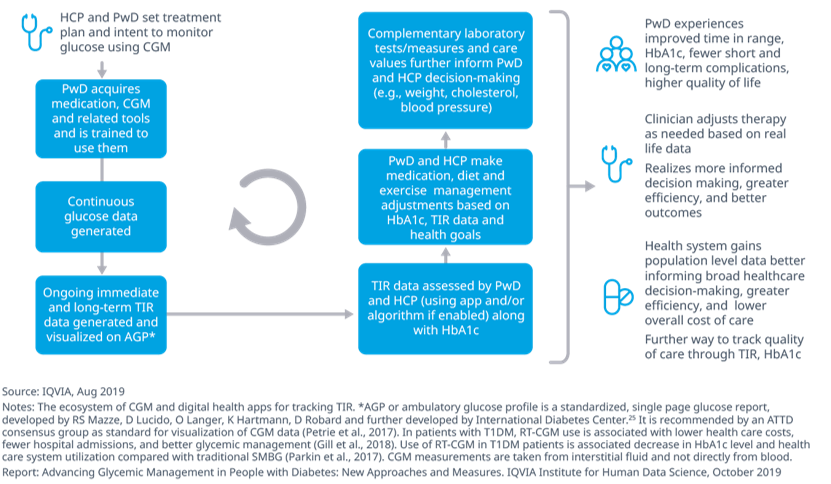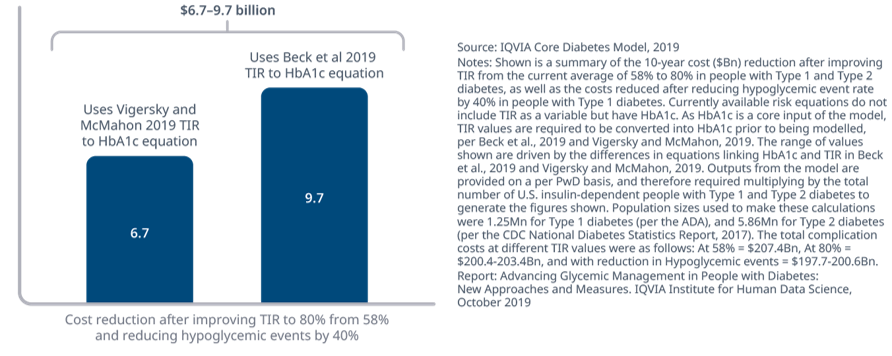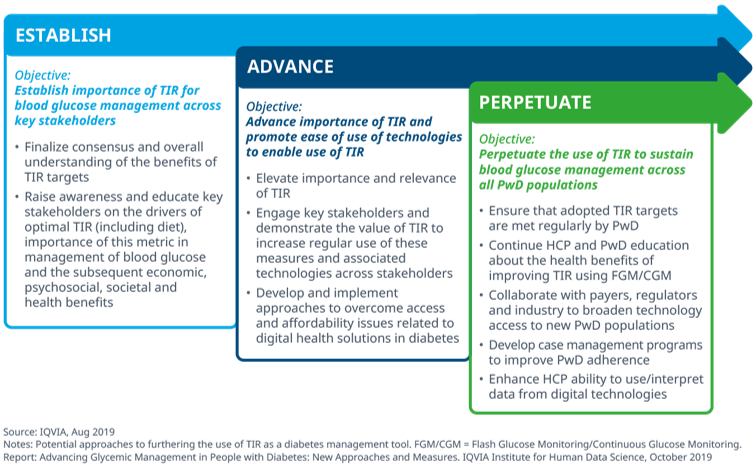About the Report
In the United States, an estimated 30.3 million individuals are affected with diabetes. If sub-optimally managed, diabetes can lead to psychosocial and physical health complications and create significant societal and economic burden. This report discusses recent advances in blood glucose management including continuous glucose monitoring and associated short-term metrics such as time in range (TIR), which determine the percentage of time a PwD spends in their glucose target range. Regular monitoring of time in range offers a new strategy to improve blood glucose management beyond the current state and thereby reduce complications in the U.S. PwD population. The report assesses TIR and determines whether improving this measure in PwD can lead to meaningful reductions in complications and costs. The report also puts forth approaches to further the use of TIR in the U.S. PwD population to improve blood glucose management.
Report Summary
Diabetes has been among the top-ten leading causes of death in the United States over the past five years, with 1.5 million diagnoses per year and a total of 30.3 million individuals affected annually. Poorly managed glucose levels in people with Type 1 or Type 2 diabetes can lead to both short- and long-term complications, including greater risk of microvascular and macrovascular complications. In addition, the high prevalence of diabetes and its complications led to direct and indirect costs of $327 billion in the United States in 2017 alone. Although advances in diabetes care have resulted in improved technologies for monitoring blood glucose, there still exists a gap in managing blood glucose in the United States.
HbA1c, an important long-term and indirect measure of blood glucose management, is used by clinicians to determine the success of management and also to understand the risk of developing diabetes-related complications. Despite its relevance and position within the clinical paradigm, HbA1c also carries with it several limitations, including its inability to identify specific periods of hyperglycemia and hypoglycemia. Recent technological advances in continuous glucose monitoring have resulted in greater recognition of metrics beyond HbA1c, including time in range (TIR), time below range (TBR) and time above range (TAR). Incorporation of these metrics alongside HbA1c are expected to enhance the way in which diabetes is managed in the future, and subsequently, reduce the overall societal and economic burden.
This report uses the IQVIA Core Diabetes Model to generate the first estimate of complications and costs that can be reduced by improving TIR. Using this model, improvements in TIR were estimated to reduce the risk of developing diabetes-related complications, such as myocardial infarction, end-stage renal disease, severe vision loss and amputation, resulting in an initial conservative estimated reduction of $6.7–9.7 billion in costs over a 10-year period.
Finally, to advance into a new era of care in diabetes — where all diabetes management tools including HbA1c and, increasingly, TIR, are optimized and personalized — the report examines various approaches to further the use of TIR that can help address the need for improved blood glucose management. There are three critical stages in this process: establishing the importance of TIR for blood glucose management across key stakeholders, advancing the use of this metric and promoting ease of use of technologies, and, lastly, perpetuating the use of TIR to sustain blood glucose management across all appropriate diabetes populations. Within this framework, approaches that can further the use of TIR are suggested from a PwD, healthcare policy, and healthcare delivery perspective, and consider issues such as advocacy, access and interoperability.
Key Findings
Blood glucose management for people with diabetes is evolving to incorporate continuous glucose monitoring

- Historically, blood glucose monitoring for people with diabetes (PwD) has included finger stick self-monitoring of blood glucose and use of a lab test, HbA1c, which indicates average blood glucose levels over a 12-week period.
- Digital health offerings in diabetes have increased in recent years, particularly with the advanced insulin pumps, continuous and flash glucose monitors (C/FGMs), and smartphone applications.
- As a result, there is now a significant amount of data generated, allowing for more regular monitoring of glucose levels by both the PwD and health care providers (HCP). These advances in technology have led to metrics, such as time in range (TIR), time below range (TBR) and time above range (TAR) gaining attention and becoming increasingly utilized by PwD and HCP to monitor glucose levels.
- TIR offers PwD with an understanding of what is taking place on a daily basis including several unique benefits that complement the use of this metric alongside HbA1c, such as notifying both the PwD and HCP about the frequency and time spent in hypoglycemic/hyperglycemic range and enabling healthcare providers and PwD to respond faster to blood glucose excursions.
Improving PwD time in range to 80% and reducing hypoglycemic events by up to 40% can, conservatively, lead to a reduction in costs of $6.7–9.7 billion over 10 years according to the IQVIA Core Diabetes Model

- Based on peer-reviewed clinical trials, PwD currently experience an average TIR of 58%, which is below the minimum consensus recommended target value of 70%, enabling an assessment of potential complications and costs that can be reduced by improving TIR to consensus values and beyond.
- Recent evidence suggests TIR of 80% and reductions in hypoglycemic events are being achieved in some cases by enhancements in technologies.
- Increase of TIR from 58% to 70% and to 80%, with and without modeling a reduction of hypoglycemic events, leads to significant cost saving of billions of dollars.
- The model also predicts that an increase in TIR reduces the cumulative incidence of developing complications such as myocardial infarction, end stage renal disease, severe vision loss and amputation.
There are a number of potential approaches to support a greater understanding and use of TIR across three stages of maturity to further its use in diabetes management

- There are three stages critical to further the use of TIR: establishing the importance of TIR for blood glucose measurement and management across key stakeholders, advancing the use of this metric and promoting ease of use of associated technologies, and, lastly, perpetuating the use of TIR to sustain blood glucose management across all appropriate diabetes populations.
- Each stage recognizes voices from PwD, advocacy organizations, and HCPs, on how to advance measurement and management tools to optimize insulin-managed diabetes.
- Activities from a healthcare policy, healthcare delivery and PwD perspective can help establish, advance and perpetuate the use of TIR. These span the domains of advocacy, access and interoperability and include collaborative efforts between PwD, HCP, industry, and government stakeholders to accelerate access to and optimization of such new management and measurement tools.

























